View in other NatureServe Network Field Guides
NatureServe
Montana
Utah
Wyoming
Idaho
Wisconsin
British Columbia
South Carolina
Yukon
California
New York
Tawny Crescent - Phyciodes batesii
General Description
[From Ferris and Brown 1981; Scott 1986; Opler and Wright 1999; Glassberg 2001] Forewing 1.5-1.8 cm. Antennae knobs black. Uppersurface of males dark with postmedian band pale-orange, submarginal band orange; female variable. Undersurface of forewing with black patch on inner margin larger (wider) than subapical patch on costa; hindwing overall pale yellow.
Phenology
One flight; mid-May to June in the south and Ottawa, mid-June to July in the north (Scott 1986). June to early August (Glassberg 2001). Late May to mid-August in Manitoba, mid June to July in Alberta and Saskatchewan (Scott 1994), late June to late July in British Columbia (Guppy and Shepard 2001).
Diagnostic Characteristics
Variable. Best determined by combination of antennae knobs black, uppersurface of forewing with median band paler orange than postmedian band, undersurface of forewing with black patch on inner margin larger (wider) than subapical patch on costa.
Species Range
Montana Range
Range Descriptions

 Native
Native
Range Comments
Northeastern British Columbia and central Alberta east to central Ontario and southwestern Quebec, south in Appalachians to northern Georgia, south in the west to northern Arizona and northwestern New Mexico; isolated population in Black Hills region of South Dakota and northwestern Nebraska, and Bighorn Mountains of Wyoming (Scott 1994; Opler and Wright 1999; Glassberg 2001), populations in Black Hills and Pine Ridge region of Nebraska are postglacial relics of former eastern deciduous forest (Johnson 1975; Kaul et al. 1988); to 2454 m elevation in Colorado (Scott 2006). In Montana, reported since 1980 from at least seven counties east of the Rocky Mountains, mainly in the north and east (Kohler 1980; Stanford and Opler 1993; FLMNH Lepidopterists' Society database). Locally rare to uncommon (Glassberg 2001).
Observations in Montana Natural Heritage Program Database
Number of Observations: 10
(Click on the following maps and charts to see full sized version)
Map Help and Descriptions
Relative Density
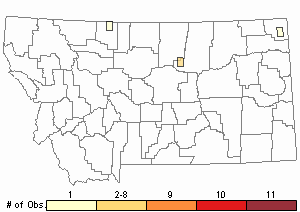
Recency
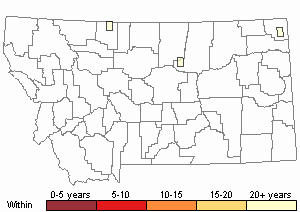
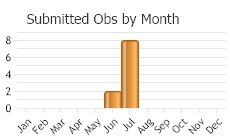
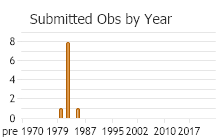
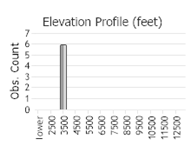 (Observations spanning multiple months or years are excluded from time charts)
(Observations spanning multiple months or years are excluded from time charts)
Migration
Non-migratory.
Habitat
Moist slopes, ravines, pastures, dry rocky ridges, deciduous woodland openings, mesic meadows, aspen stands, riparian corridors (Opler and Wright 1999; Glassberg 2001; Guppy and Shepard 2001). Habitat in Montana not described but probably similar.
Food Habits
Larval food plants include Eurybia and at least three species of Symphyotrichum (Scott 1986, 1994, 2006). Adults feed on flower nectar (including Achillea, Cirsium, Erigeron, Eriogonum, Eurybia, Grindelia, Machaeranthera, Medicago, Rudbeckia, Viguiera), carrion, and mud (Scott 2014).
Reproductive Characteristics
Females lay eggs in clusters (up to 128 eggs per cluster) on the underside of host plant leaves. L1-L2 instars live on thin silk nest on underside of leaves, overwinter (hibernate) as L4 (also L3?) instar. Development from oviposition to eclosion (adult emergence from pupae) 51 days in captivity (depending on temperature), L1 instar to pupae in 55-57 days. Adult eclosion in 8-13 days after pupation (Scott 1979, 1986, 1994, 2006). Males patrol throughout the day in canyon bottoms in search of females (Scott 1994).
Stewardship Responsibility
References
- Literature Cited AboveLegend:
 View Online Publication
View Online Publication Ferris, C.D. and F.M. Brown (eds). 1981. Butterflies of the Rocky Mountains. Univ. of Oklahoma Press. Norman. 442 pp.
Ferris, C.D. and F.M. Brown (eds). 1981. Butterflies of the Rocky Mountains. Univ. of Oklahoma Press. Norman. 442 pp. Glassberg, J. 2001. Butterflies through Binoculars: A Field Guide to the Butterflies of Western North America. Oxford University Press.
Glassberg, J. 2001. Butterflies through Binoculars: A Field Guide to the Butterflies of Western North America. Oxford University Press. Guppy, C.S. and J.H. Shepard. 2001. Butterflies of British Columbia: including western Alberta, southern Yukon, the Alaska Panhandle, Washington, northern Oregon, northern Idaho, northwestern Montana. UBC Press (Vancouver, BC) and Royal British Columbia Museum (Victoria, BC). 414 pp.
Guppy, C.S. and J.H. Shepard. 2001. Butterflies of British Columbia: including western Alberta, southern Yukon, the Alaska Panhandle, Washington, northern Oregon, northern Idaho, northwestern Montana. UBC Press (Vancouver, BC) and Royal British Columbia Museum (Victoria, BC). 414 pp. Johnson, K. 1975. Post-Pleistocene environments and montane butterfly relicts on the western Great Plains. Journal of Research on the Lepidoptera 14(4): 216-232.
Johnson, K. 1975. Post-Pleistocene environments and montane butterfly relicts on the western Great Plains. Journal of Research on the Lepidoptera 14(4): 216-232. Kaul, R.B., G.E. Kantak, and S.P. Churchill. 1988. The Niobrara River valley, a postglacial migration corridor and refugium of forest pants and animals in the grasslands of central North America. Botanical Review 54(1): 44-81.
Kaul, R.B., G.E. Kantak, and S.P. Churchill. 1988. The Niobrara River valley, a postglacial migration corridor and refugium of forest pants and animals in the grasslands of central North America. Botanical Review 54(1): 44-81. Kohler, S. 1980. Checklist of Montana Butterflies (Rhopalocera). Journal of the Lepidopterists' Society 34(1): 1-19.
Kohler, S. 1980. Checklist of Montana Butterflies (Rhopalocera). Journal of the Lepidopterists' Society 34(1): 1-19. Opler, P.A. and A.B. Wright. 1999. A field guide to western butterflies. Second edition. Peterson Field Guides. Houghton Mifflin Company, Boston, Massachusetts. 540 pp.
Opler, P.A. and A.B. Wright. 1999. A field guide to western butterflies. Second edition. Peterson Field Guides. Houghton Mifflin Company, Boston, Massachusetts. 540 pp. Scott, J.A. 1979. Hibernal diapause of North American Papilionoidea and Hesperioidea. Journal of Research on the Lepidoptera 18(3): 171-200.
Scott, J.A. 1979. Hibernal diapause of North American Papilionoidea and Hesperioidea. Journal of Research on the Lepidoptera 18(3): 171-200. Scott, J.A. 1986. The butterflies of North America: a natural history and field guide. Stanford University Press, Stanford, California.
Scott, J.A. 1986. The butterflies of North America: a natural history and field guide. Stanford University Press, Stanford, California. Scott, J.A. 1994. Biology and Systematics of Phyciodes (Phyciodes) [Lepidoptera, Nymphalidae]. Papilio, New Series #7: 120.
Scott, J.A. 1994. Biology and Systematics of Phyciodes (Phyciodes) [Lepidoptera, Nymphalidae]. Papilio, New Series #7: 120. Scott, J.A. 2006. Butterfly hostplant records, 1992-2005, with a treatise on the evolution of Erynnis, and a note on new terminology for mate-locating behavior. Papilio new series #14. 74 p.
Scott, J.A. 2006. Butterfly hostplant records, 1992-2005, with a treatise on the evolution of Erynnis, and a note on new terminology for mate-locating behavior. Papilio new series #14. 74 p. Scott, J.A. 2014. Lepidoptera of North America 13. Flower visitation by Colorado butterflies (40,615 records) with a review of the literature on pollination of Colorado plants and butterfly attraction (Lepidoptera: Hersperioidea and Papilionoidea). Contributions of the C.P. Gillette Museum of Arthopod Diversity. Fort Collins, CO: Colorado State University. 190 p.
Scott, J.A. 2014. Lepidoptera of North America 13. Flower visitation by Colorado butterflies (40,615 records) with a review of the literature on pollination of Colorado plants and butterfly attraction (Lepidoptera: Hersperioidea and Papilionoidea). Contributions of the C.P. Gillette Museum of Arthopod Diversity. Fort Collins, CO: Colorado State University. 190 p. Stanford, R.E. and P.A. Opler. 1993. Atlas of western USA butterflies: including adjacent parts of Canada and Mexico. Unpubl. Report. Denver and Fort Collins, Colorado 275 pp.
Stanford, R.E. and P.A. Opler. 1993. Atlas of western USA butterflies: including adjacent parts of Canada and Mexico. Unpubl. Report. Denver and Fort Collins, Colorado 275 pp.
- Additional ReferencesLegend:
 View Online Publication
View Online Publication
Do you know of a citation we're missing? Allen, T.J., J.P. Brock, and J. Glassberg. 2005. Caterpillars in the field and garden: a field guide to the butterfly caterpillars of North America. Oxford University Press.
Allen, T.J., J.P. Brock, and J. Glassberg. 2005. Caterpillars in the field and garden: a field guide to the butterfly caterpillars of North America. Oxford University Press. Brock, J.P. and K. Kaufman. 2003. Kaufman Field Guide to Butterflies of North America. Houghton Mifflin Company, New York, NY 284 pp.
Brock, J.P. and K. Kaufman. 2003. Kaufman Field Guide to Butterflies of North America. Houghton Mifflin Company, New York, NY 284 pp. Forister, M.L., E.M. Grames, C.A. Halsch, K.J. Burls, C.F. Carroll, K.L. Bell, J.P. Jahner, et al. 2023. Assessing risk for butterflies in the context of climate change, demographic uncertainty, and heterogeneous data sources. Ecological Monographs 93(3):e1584. https://doi.org/10.1002/ecm.1584
Forister, M.L., E.M. Grames, C.A. Halsch, K.J. Burls, C.F. Carroll, K.L. Bell, J.P. Jahner, et al. 2023. Assessing risk for butterflies in the context of climate change, demographic uncertainty, and heterogeneous data sources. Ecological Monographs 93(3):e1584. https://doi.org/10.1002/ecm.1584 Layberry, R.A., P.W. Hall, and J.D. LaFontaine. 1998. The Butterflies of Canada. University of Toronto Press. 280 pp. + color plates.
Layberry, R.A., P.W. Hall, and J.D. LaFontaine. 1998. The Butterflies of Canada. University of Toronto Press. 280 pp. + color plates. Opler, P.A. and A.D. Warren. 2002. Scientific names list for butterfly species of North America, north of Mexico. C.P Gillette Museum of Arthropod Diversity, Department of Bioagricultural Sciences and Pest Management, Colorado State University, Fort Collins, Colorado. 79 pp.
Opler, P.A. and A.D. Warren. 2002. Scientific names list for butterfly species of North America, north of Mexico. C.P Gillette Museum of Arthropod Diversity, Department of Bioagricultural Sciences and Pest Management, Colorado State University, Fort Collins, Colorado. 79 pp.
- Web Search Engines for Articles on "Tawny Crescent"
- Additional Sources of Information Related to "Insects"





